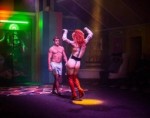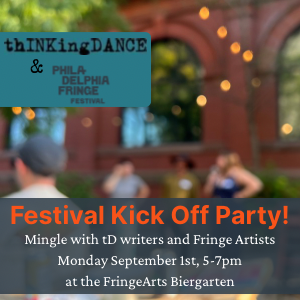
Top Five Reasons You Should (or Shouldn’t?) Dance in Your Living Room
by Whitney Weinstein
1. You never have to leave home.
The cool thing about Hearsay’s venue: it houses some of BodyFields’s members. Strung along the walls were handmade “Happy Birthday!!!!!” signs and multicolored Christmas lights for ambiance. Wine and snacks were provided in the kitchen. Nikki Roberts nonchalantly sat drinking coffee until she stood up from the audience to dance. Essentially, the 25-30 audience members arrived and stayed as guests in the Reed Street home. It was casual and cozy. The downside for those who live there: you have to strike the set.
2. You don’t have to prepare anything.
The informality of the night reminded me of a “Works In Progress” showing (a chance for performers to get feedback on work during its development and often prior to a more formal staging); however, I knew this was something different when a number of artists preceded their act by laughing and stating, “I’m entirely unprepared.” Was this simply an opportunity to be silly with friends on a Saturday night? Despite these claims of meager material, pieces that were supposed to run less than ten minutes generally ran around fifteen, stretching the event thirty minutes past its scheduled time. Some of the unrehearsed activities were upsetting, while some acts held my interest.
Example #1: The opening performer, Jonathan Childs, stood aimlessly in front of the audience for five minutes before saying that he was going to engage in nonverbal communication with us. At that point, he began to sporadically make ghost sounds and give hugs. He spoke laxly, and in circles, as if desperately attempting to fill the time until the end of his act with “maybes” and “uhms.”I could not decipher an intention.
There is a difference between simply being unprepared and adapting a plan for improvisation. A spontaneous willingness to engage the audience in a pre-set process is much more productive than addressing a crowd with undirected ramblings.
3. There’s an opportunity to reconnect with lost friends and cuddle up to some new ones.
…but wear clean socks. Upon entry, audience members were asked to shed their footwear. The venue consisted of the living room where people squeezed together to make space for seats, a kitchen, and another room where performers and audience could stand and chat. The small size of the space ensured that everyone was thrust into mingling with the eclectic, shoeless crowd.
4. People get creative in contained spaces.
In this South Philly home, thirty-five people consumed a considerable amount of the available space, leaving only a modest stage in the back center of the room. Aside from playing instruments and telling jokes, performers improvised thoughtful conversation, had “Show and Tell” with dismembered pieces of taxidermy, and juggled. The work on display was random and disconnected, but definitely creative. Most interesting to watch was a dance piece by Briel Driscoll and Nikki Roberts. Ironically, their professionalism shined amidst all the informality: they were able to maneuver around audience bodies, maintain clear articulation in speaking roles during movement, and present a short piece that exemplified cohesiveness. Another highlight of the evening came when a Peruvian pan flutist charmed us with a story of his interest in playing the instrument, a brief history of the flute, and a selection of short songs.
5. A magnifying glass is focused on the performers and their process.
BodyFields Performance Collective, 702 Reed Street. April 5.
By Whitney Weinstein
April 11, 2014









